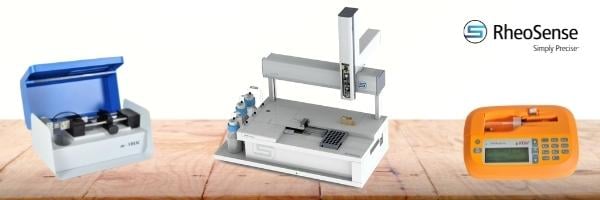Over the coming weeks, we will be sharing a blog series, discussing the use of viscosity for fluid characterization and how this can assist in optimizing practical laboratory and field operations. Our previous oil and gas blog “Importance of Viscosity in Hydraulic Fracturing Systems” provided a broad overview of how viscosity is commonly used to QC frac fluids in the lab and on-the-fly. In this series, we will cover new testing techniques, in-depth rheological characterization, and what instruments are best to use. I will highlight the benefits of using RheoSense’s microfluidic-based VROC technology over traditional rotating and gravity-driven viscosity measurement systems as well as how RheoSense and our viscometers provide users with the ability to gather the necessary fluid characteristics to help improve a variety of systems their company deals with on a daily basis.
Before we begin discussing testing, we need to understand the options for measuring devices and where some of these fall short.
Let’s start with the rotational viscometer, which is the most common type of viscometer, and the one used throughout the oil and gas industry for most measurements. These systems have some benefits that make them a good choice for both field and laboratory operations such as quick measurements, rugged construction, can test a wide range of viscosities, have heating capabilities, and allow for testing at multiple shear rates. Cup and bob viscometers, that are the current choice for frac sites, only provide a reference value for viscosity and have issues with accuracy which is okay for simple spot checks on fluid systems but not when you truly need to understand and analyze your fluid system. An example: You are supposed to be running a 20ppt Guar-based gel system. Your Fann 35 reading bounces between a few values, but it is close to the value you are looking for. Turns out that you were close…but off by 2ppt so you run a 22ppt loading the entire job. So that “small” accuracy error could end up costing you 10,000+ lbs of dry gel by the end of the job. Beyond these concerns, many rotational viscometers require a significant amount of training to properly operate the instrument, and the data they provide can be affected by inconsistencies in operator procedures such as sample preparation (which can be very tedious and difficult for cone and plate type viscometers), test protocols or turbulence in the sample caused by the rotating mechanism itself.
Another relatively common viscosity measurement device used in the oil and gas industry is a type of gravity-driven system called the Marsh funnel. Capillary tube viscometers fall under this category as well. Gravity-driven viscometers are easy to operate, but they only allow you to test at one shear rate (based mostly on the weight of the fluid) and require calculations to obtain a reference value for viscosity and not a true or dynamic viscosity which does NOT help properly characterize the sample only provides a general idea of the current sample properties. Along with rotational viscometers, these tend to be quite difficult to clean.
**Learn more about the different types of viscometers**
If you are not familiar with RheoSense or our products, I would first tell you that RheoSense viscometers are not only easy to use but also provide highly accurate (2% of reading) and repeatable (0.5% RSD) data across a wide range of viscosities, shear rates and temperatures. RheoSense viscometers are extremely easy to use with basically three steps from sample to measurement: Pull up the sample in your syringe/pipette, load the syringe/pipette into the instrument (push or screw it in), and press “Run”…This is all that you have to do on most of our instruments to obtain a dynamic viscosity measurement for your sample. Cleaning is just as easy. Simply pull your cleaning solvent into your syringe/pipette, load it into the instrument and run the entire volume (may require multiple runs and/or multiple solvents or surfactants depending on your sample). Our technology allows for the smallest minimum sample requirements throughout the industry (26-100 microliters), and it precisely measures extremely low viscosities up to 100,000+ cP. You may consider our microVISC if you need quick, accurate spot checks or portability. For wider shear rate ranges or temperature ranges (80 degrees C or 105 degrees C), you would need to ask about our m-VROC II with high temperature capabilities. If you need extensional viscosity, our e-VROC is an excellent option. If you are running an excessive amount of samples daily, have extremely low sample volumes or just need to save time…you should consider our fully-automated Initium one plus.

**You can not run proppant in your samples with our devices. The grains are too large for our flow channels and would clog your chip making it irreparable. **
Now that we have touched on the types of measuring devices, we can get into the testing. In the next blogs in this series, am going to cover three points:
- High Viscosity Friction Reducers (HVFR): Measuring viscosity, break test at downhole conditions, and viscoelastic properties
- Produced Oil: Simulating the path from formation to surface
- Motor Oil/Engine Lubricants: Why proper testing is key
Stay tuned for the release of our next blog in the series, or visit our applications library to learn more about measuring viscosity of oils with our VROC technology!
Written by: Tyler Etheredge, RheoSense Technical Sales Representative

